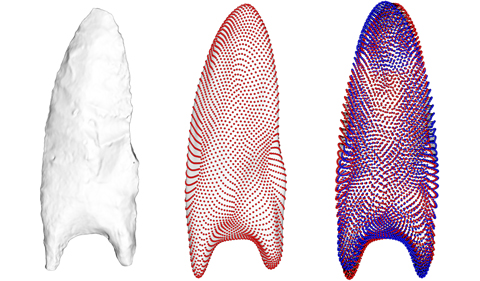
Dr. Joseph Gingerich
Dr. Joseph Gingerich, Assistant Professor of Anthropology, co-authored a journal article PLOS ONE titled “Tracing social interactions in Pleistocene North America via 3D model analysis of stone tool asymmetry.”
Gingerich and the research team used 3D imaging and morphometric analysis to study subtle changes in how early inhabitants in North America crafted their tools. Focusing on stone spear points dating between 12,000 – 13,000 year ago, the research team found evidence of highly specialized manufacturing techniques that were taught and maintained through interaction between tool makers.
“By documenting changes in stone tool technology, we also track changes in social interactions,” Gingerich said in a Smithsonian article headlined “Scientists Find Traces of Adaptation and Cultural Diversification Among Early North American Stone Tools.”

Scientists analyzed three-dimensional models of Clovis projectile points from Smithsonian and other museum collections to examine how patterns and marks made in crafting these tools began to vary regionally 12,500 years ago. These regional differences signal cultural diversification and adaptation, suggesting that groups of early hunter-gatherer Americans may have changed the way they were social interacting at this time. This figure shows one analysis used to study shapes left behind from their production on either side of the projectile points. Credit: Sebastian Wärmländer, Stockholm University
Using new methods to analyze stone projectile points crafted by North America’s earliest human inhabitants, Smithsonian scientists have found that these tools show evidence of a shift toward more experimentation in their production beginning about 12,500 years ago, following hundreds of years of consistent stone-tool production created using uniform techniques. The findings provide clues into changes in social interactions during a time when people are thought to have been spreading into new parts of North America and adapting to different environments, beginning a period of cultural diversification.
The research team, led by Sabrina Sholts, a curator in the Department of Anthropology at the Smithsonian’s National Museum of Natural History, used digital 3-D models to scrutinize the angles and contours on the surfaces of North American projectile points. In doing so, they discovered a turning point at which the techniques used to produce the points became more variable. That variability suggests that individual toolmakers, who may have had fewer opportunities than their predecessors to learn from others, began working out how to make the tools on their own. The findings were reported July 12 in the journal PLOS ONE.
“Our study really allows stone tools to speak in a new way,” said Joseph Gingerich, a research associate at the Smithsonian and assistant professor of anthropology at Ohio University. “By being able to document subtle changes in stone tool technology, we can better understand how social interactions among artisans changed in North America over 12,000 years ago.”
The earliest well-documented group of people in North America, known as Clovis, is recognized by distinctive pointed stone projectiles that appear about 13,500 years ago. These culture-defining tools, called Clovis points, are sharp-edged and symmetrical, with a groove near the base—called a flute—where a spear shaft may have fit. Anthropologists consider them to be a very sophisticated technology….
“For a long time in North America, the archaeological record shows both consistency in stone tool technology and other aspects of culture,” Gingerich said. “In documenting a change in stone tool technology, we likely document the start of greater regional adaptations among some of the first hunter-gatherers in North America.”
Abstract of the PLOS ONE article: Stone tools, often the sole remnant of prehistoric hunter-gatherer behavior, are frequently used as evidence of ancient human mobility, resource use, and environmental adaptation. In North America, studies of morphological variation in projectile points have provided important insights into migration and interactions of human groups as early as 12–13 kya. Using new approaches to 3D imaging and morphometric analysis, we here quantify bifacial asymmetry among early North American projectile point styles to better understand changes in knapping technique and cultural transmission. Using a sample of 100 fluted bifaces of Clovis and post-Clovis styles in the eastern United States ca. 13,100–9,000 cal BP (i.e., Clovis, Debert-Vail, Bull Brook, Michaud-Neponset/Barnes, and Crowfield), we employed two different approaches for statistical shape analysis: our previously presented method for analysis of 2D flake scar contours, and a new approach for 3D surface analysis using spherical harmonics (SPHARM). Whereas bifacial asymmetry in point shape does not vary significantly across this stylistic sequence, our measure of asymmetric flake scar patterning shows temporal variation that may signify the beginning of regionalization among early New World colonists.



















Comments